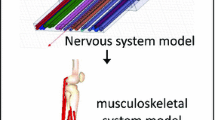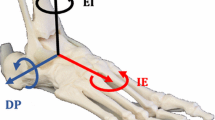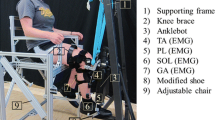Abstract
The main goal of the present study was to estimate the ankle joint angle from the peroneal and tibial electroneurography (ENG) recordings. Two single-channel cuff electrodes for recording ENG were placed on the proximal part of rabbit peroneal and tibial nerves respectively and static positioning and ramp-and-hold stretches were performed to characterize the static and dynamic ENG responses. An ENG model, consisting of static and dynamic parts, was constructed to relate ENG to ankle angle trajectory and an inverse ENG model was derived to predict ankle angle. The results showed that the new model could accurately estimate large-range ankle angles during and after ramp-and-hold movements. Our study provides a basis for implementing joint angle tracing without using artificial angle sensors.









Similar content being viewed by others
References
Boyd IA (1976) The response of fast and slow nuclear bag fibers and nuclear chain fibers in isolated cat muscle spindles to fusimotor stimulation, and the effect of intrafusal contraction on the sensory endings. Q J Exp Physiol 61:203–254
Cavallaro E, Micera S, Dario P, Jensen W, Sinkjær T (2003) On the intersubject generalization ability in extracting kinematic information from afferent nervous signals. IEEE Trans Biomed Eng 50(9):1063–1073
Cheng HS, Ju MS, Lin CCK (2003) Improving elbow torque output of stroke patients with assistive torque controlled by EMG signals. ASME Trans Biomech Eng 125:881–886
Cheng HS, Ju MS, Lin CCK (2005) Estimation of peroneal and tibial afferents from a multi-channel cuff placed on the sciatic nerve. Muscle Nerve 32:589–599
Collins DF, Refshauge KM, Todd G, Gandevia SC (2005) Cutaneous receptors contribute to kinesthesia at the index finger, elbow, and knee. J Neurophysiol 94:1699–1706
Ferrell WR (1980) The adequacy of stretch receptors in the cat knee joint for signalling joint angle throughout a full range of movement. J Physiol 299:85–99
Grill WM, McDonald JW, Peckham PH, Heetderks W, Kocsis J, Weinrich M (2001) At the interface: convergence of neural regeneration and neural prostheses for restoration of function. J Rehabil Res Dev 38(6):633–639
Halata Z, Wagner C, Baumann KI (1999) Sensory nerve endings in the anterior cruciate ligament (lig. Cruciatum anterius) of sheep. Anat Rec 254:13–21
Haugland M, Lickel A, Haase J, Sinkjær T (1999) Control of FES thumb force using slip information obtained from the cutaneous electroneurogram in quadriplegic man. IEEE Trans Rehabil Eng 7(2):215–227
Haugland M, Sinkjær T (1995) Cutaneous whole nerve recordings used for correction of footdrop in hemiplegic man. IEEE Trans Rehabil Eng 3(4):307–317
Haugland MK, Hoffer JA (1994) Artifact-free sensory nerve signals obtained from cuff electrodes during functional electrical stimulation of nearby muscles. IEEE Trans Rehabil Eng 2(1):37–40
Haugland MK, Hoffer JA (1994) Slip information provided by nerve cuff signals: application in closed-loop control of functional electrical stimulation. IEEE Trans Rehabil Eng 2(1):29–36
Jensen W, Lawrence SM, Riso RR, Sinkjær T (2001) Effect of initial joint position on nerve-cuff recordings of muscle afferents in rabbits. IEEE Trans Neural Syst Rehabil Eng 9(3):265–273
Jensen W, Sinkjær T, Sepulveda F (2002) Improving signal reliability for on-line joint angle estimation from nerve cuff recordings of muscle afferents. IEEE Trans Neural Syst Rehabil Eng 10(3):133–139
Ju MS, Chien HC, Chen GS, Lin CCK, Chang CH, Chang CW (2002) Design and fabrication of multi-microelectrode array for neural prosthesis. Chin J Med Biol Eng 22:33–40
Khalsa PS, Hoffman AH, Grigg P (1996) Mechanical states encoded by stretch-sensitive neurons in feline joint capsule. J Neurophysiol 76:175–187
Latash ML (1993) Control of human movement. Human Kinetics Publishers, Chicago
Micera S, Jensen W, Sepulveda F, Riso RR, Sinkjær T (2001) Neuro-fuzzy extraction of angular information from muscle afferents for ankle control during standing in paraplegic subjects: an animal model. IEEE Trans Biomed Eng 48(7):787–794
Nade S, Newbold PJ, Straface SF (1987) The effects of direction and acceleration of movement of the knee joint of the dog on medial articular nerve discharge. J Physiol 388:505–519
Park E, Meek SG (1995) Adaptive filtering of the electromyographic signal for prosthetic control and force estimation. IEEE Trans Biomed Eng 42(10):1048–1052
Riso RR, Mosallaie FK, Jensen W, Sinkjær T (2000) Nerve cuff recordings of muscle afferent activity from tibial and peroneal nerves in rabbit during passive ankle motion. IEEE Trans Rehabil Eng 8(2):244–258
Strange KD, Hoffer JA (1999) Gait phase information provided by sensory nerve activity during walking: applicability as state controller feedback for FES. IEEE Trans Biomed Eng 46(7):797–809
Yoshida K, Horch K (1996) Closed-loop control of ankle position using muscle afferent feedback with functional neuromuscular stimulation. IEEE Trans Biomed Eng 43(2):167–176
Zhang LQ, Chung SG, Bai Z, Xu D, van Rey EMT, Rogers MW et al (2002) Intelligent stretching of ankle joints with contracture/spasticity. IEEE Trans Neural Syst Rehabil Eng 10(3):149–157
Acknowledgments
This study was partly supported by the ROC National Health Research Institutes under Contract No. NHRI-EX92-9017EP.
Author information
Authors and Affiliations
Corresponding author
Rights and permissions
About this article
Cite this article
Lin, CC.K., Ju, MS. & Cheng, HS. Model-based ankle joint angle tracing by cuff electrode recordings of peroneal and tibial nerves. Med Bio Eng Comput 45, 375–385 (2007). https://doi.org/10.1007/s11517-007-0162-5
Received:
Accepted:
Published:
Issue Date:
DOI: https://doi.org/10.1007/s11517-007-0162-5




